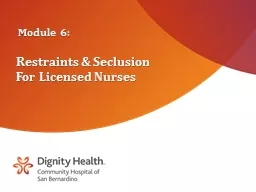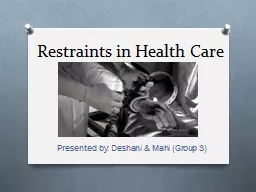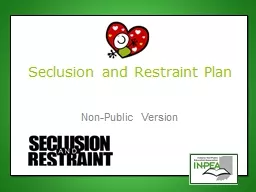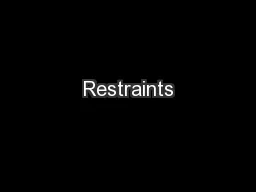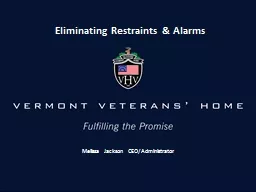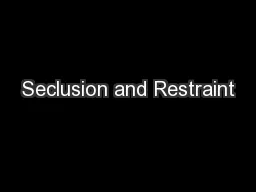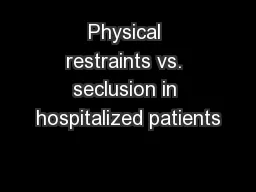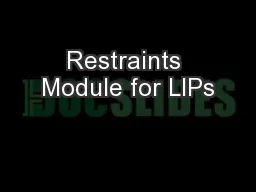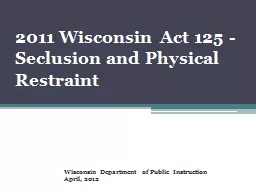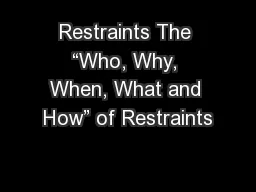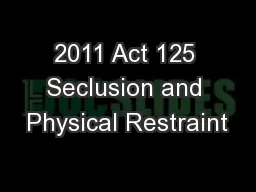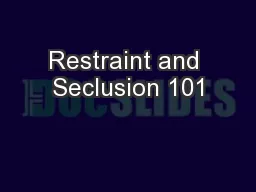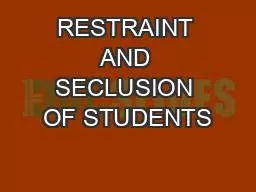PPT-Restraints & Seclusion
Author : calandra-battersby | Published Date : 2018-10-25
For Licensed Nurses Module 6 Restraint Any manual method physical or mechanical device material or equipment that immobilizes or reduces the ability of a patient
Presentation Embed Code
Download Presentation
Download Presentation The PPT/PDF document "Restraints & Seclusion" is the property of its rightful owner. Permission is granted to download and print the materials on this website for personal, non-commercial use only, and to display it on your personal computer provided you do not modify the materials and that you retain all copyright notices contained in the materials. By downloading content from our website, you accept the terms of this agreement.
Restraints & Seclusion: Transcript
For Licensed Nurses Module 6 Restraint Any manual method physical or mechanical device material or equipment that immobilizes or reduces the ability of a patient to move hisher arms legs body or head freely If the patient can easily remove the device material or equipment it is not considered a restraint . Method . People admitted to the Emergency Room of . Instituto. Philippe . Pinel. , Rio de Janeiro, Brazil, whose aggression/agitation was thought due to psychosis and for whom staff were unsure if best to restrict using physical restraints or a seclusion room, were randomly allocated to one or the other and followed up to 14 days (primary outcome - ‘No need to early. Presented by: . Deshani. & . Mahi. (Group 3). Introduction. Restrain: Definition. Types of Restrains. Physical Restrains . Mechanical Restrains . Chemical Restrains . Psychological Restrains . Technological Surveillance . Non-Public Version. New Legislation. Indiana Senate Bill 345. SEA 345 . intends to protect the safety of all students by providing training and guidelines for the safe and rare use of seclusion and restraint with students who pose imminent danger to themselves or others. This document is intended to both inform and serve as a resource to school leaders as they work to implement the intent of the legislation. Restraints. Who Can be Restrained?. Restraints are . only used . if necessary . to ensure . the immediate physical safety. of the patient, staff members, or others . Example- . . a patient who is pulling at or compromising important tubes, lines, or other treatments. Melissa . Jackson . CEO/Administrator. 2. Some Facts:. In . 1991, 69% of residents in nursing homes in the U.S. . were . restrained. . (CMS) . In 2011, the national average . of residents . in nursing . OAC Rules 5122-26-16 through 16.2. Effective April 1, 2016. Janel M. Pequignot, Chief. Licensure and Certification. John R. Kasich. , . Governor. Tracy J. Plouck. , . Director. Promoting Wellness and Recovery. Josha. Harvey. COHP 450. Introduction. PICO Question: In hospitalized patients, how does the use of seclusion compared to physical restraints, affect aggressive behavior?. Search words: physical restraints, seclusion, aggressive, behavior. A webinar facilitated by Tracy Harris. Coordinator for Behavioral Supports. Vermont Agency of Education. Discipline and Rule 4500. First, some . definitions. :. Physical Escort . Temporary. , without use of force, met with minimal . . Restraints are limited to those situations where there is appropriate clinical justification. Restraints will be selected when alternative interventions have been attempted and determined to be ineffective to protect the patient and/or others from harm. Wisconsin Department of Public Instruction . April, 2012. Objectives. Coverage. Definitions. Physical Restraint. Seclusion. Notification and Reporting. Training. Special Education Requirements. Applicability of other statutory provisions. Restraints. Who Can be Restrained?. Patients that may be at risk for harming themselves.. For example, patients may be pulling at or compromising important tubes, lines, and other treatments. . Why would we need to restrain a patient?. Wisconsin Department of Public Instruction’s 2017 State Superintendent’s Conference on Special Education and Pupil Services Leadership Issues . Context. According to the Office of Civil Rights (OCR), students with disabilities served by IDEA are restrained and secluded at higher rates than students without disabilities. . A Review of the National Legislation Landscape prepared for the North Dakota Seclusion and Restraint Task Force. Agenda. Brief History. Restraint and Seclusion Legislation Summary. Questions and Comments. Physical restraint and seclusion may only be used by Dinwiddie County School Board staff for the purpose of behavioral intervention in accordance with this policy and the Virginia Board of Education R
Download Document
Here is the link to download the presentation.
"Restraints & Seclusion"The content belongs to its owner. You may download and print it for personal use, without modification, and keep all copyright notices. By downloading, you agree to these terms.
Related Documents

